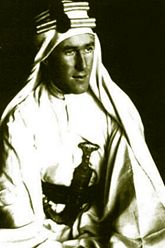T. E. Lawrence

Lieutenant-Colonel Thomas Edward Lawrence, CB, DSO (August 16, 1888 – May 19, 1935), known professionally as T. E. Lawrence, was a British soldier renowned especially for his liaison role during the Arab Revolt of 1916-18, but whose vivid personality and writings, along with the extraordinary breadth and variety of his activities and associations, have made him the object of fascination throughout the world as "Lawrence of Arabia".
Lawrence's public image was due in part to U.S. traveler and journalist Lowell Thomas' sensationalised reportage of the Revolt, as well as to Lawrence's autobiographical account, Seven Pillars of Wisdom.
Early years
Lawrence was born in 1888 in Tremadog, Caernarfonshire, North Wales. His Anglo-Irish father, Sir Thomas Robert Tighe Chapman, seventh Baronet of Westmeath in Ireland, had abandoned his wife, Edith, for his daughters' governess, Sarah Junner. The couple did not marry. Sir Thomas and Sarah had five illegitimate sons, of whom Thomas Edward was the second-eldest. The family later lived at 2 Polstead Road (now marked with a blue plaque) in Oxford, under the names of Mr and Mrs Lawrence. Thomas Edward (known in the family as "Ned") attended the City of Oxford High School for Boys, where one of the four houses is now named "Lawrence" in his honour. In about 1905, Lawrence ran away from home and served for a few weeks as a boy soldier with the Royal Regiment of Artillery at St Mawes Castle in Cornwall; he was bought out.
From 1907 Lawrence was educated at Jesus College, University of Oxford. During the summers of 1907 and 1908, he toured France by bicycle, collecting photographs, drawings and measurements of castles dating from the crusader period. Subsequently, in the summer of 1909, he set out alone on a three-month walking tour of crusader castles in Syria, during which he traveled 1,000 miles on foot. Lawrence graduated with First Class Honours after submitting a thesis on The influence of the Crusades on European Military Architecture – to the end of the 12th century; the thesis was based on his own field research in France and the Middle East.
On comp